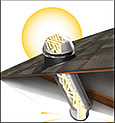Passive Solar Lighting
Solar Daylighting, also known as passive lighting, is a form of passive solar design. Daylighting uses direct, diffused or reflected sunlight to provide supplemental lighting for building interiors. Daylighting can fully replace electric lights, or it can be used to cut down on electrical costs by supplementing electrical lighting already being used.
Solar Daylighting Windows
Solar daylighting primarily occurs through large windows (facing south in the Northern Hemisphere). Buildings that use solar daylighting require specific placement and spacing of windows. For example, windows that are higher up on a wall distribute sunlight better.
Clerestory windows (a row of windows located at the top of a wall, near the roof) are an important part of daylighting in museums and churches. Skylights, when combined with sensors and other lighting elements, can ensure that lighting inside a building stays even.
Chemical compounds in windows for solar daylighting can be made part of window glass or placed between the panes of double- and triple-paned windows. These compounds can boost how much solar energy a window can store. They can also increase the insulating capacity of windows. Coatings and glazings on the windows can control the amount of light or heat. The heating effect of daylighting can be increased by window coatings that are antireflective. Some window coatings can carry an electric current that can moderate how much light or heat is let in based on weather conditions. One type of glazing can allow a measured amount of light to pass through a window while keeping heat out.
Skylights are often used for daylighting. White translucent acrylic is a 'Lambertian Diffuser' meaning transmitted light is perfectly diffused and distributed evenly over affected areas. This means, among other advantages, that light source quality standards are measured relative to white acrylic transmission. Skylights admit more light per unit area than windows, and distribute it more evenly over a space. They are a good choice when daylight is being used to illuminate a space. The optimum number of skylights (usually quantified as "effective aperture") varies according to climate, latitude, and the characteristics of the skylight, but is usually 4-8% of floor area.
Light shelves can also be used. They are placed so that the sunlight drawn in by the windows is reflected and lights a room from top to bottom. These shelves can bring natural light deeper into a room.
New technologies
Heliostats, which are the same mirrors used in solar power towers, can track the movement of the sun during the day and reflect the sunshine into windows.

Fiber Optic Daylighting is a unique way to bring natural light deep into an interior space. You can even bring natural, healthy sunlight into your basement! These cables can be routed through walls or ceilings and bent around obstructions. Each fiber optic cable can be used to bring the natural light to different interior rooms; or they can be combined in one room.
As solar daylighting provides light during the day, the amount of heat gain from electric lighting is reduced significantly. Daylighting also makes homes and buildings less gloomy. However, homes and buildings that use daylighting often have to deal with issues such as heat and glare. If the natural lighting is not regulated, the system is not properly designed, or the correct type of window for the local environment is not used, homes and buildings can become hotter than they would were daylighting not used. Daylighting can potentially increase cooling costs during the summer because there is more natural light inside. Daylighting will not work everywhere because there is not enough sunshine in some locations.
Because of daylighting’s positive effects on people, workers in offices with daylighting are more productive. There are fewer absences and errors by such workers. When workers’ productivity is increased, businesses can become more successful. Daylighting can even affect shoppers. Shopping centers and malls that incorporate daylighting into their design find that more natural light may lead to increased sales.
Passive Solar Lighting copyright 2011 Digtheheat.com
